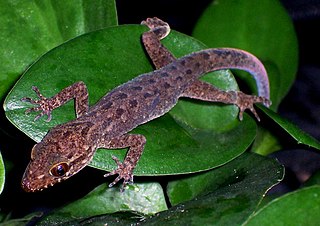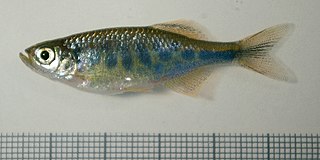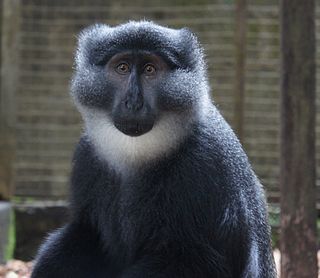
Insects in the family Tettigoniidae are commonly called katydids, or bush crickets. They have previously been known as "long-horned grasshoppers". More than 6,400 species are known. Part of the suborder Ensifera, the Tettigoniidae are the only extant (living) family in the superfamily Tettigonioidea.

Cyrtodactylus is a diverse genus of Asian geckos, commonly known as bent-toed geckos, bow-fingered geckos, and forest geckos. The genus has at least 300 described species as of 2020, which makes it the largest of all gecko genera.

The family Gryllidae contains the subfamilies and genera which entomologists now term true crickets. They belong to the Orthopteran subfamily Ensifera, having long, whip-like antennae and has been reduced in terms of the older literature, with taxa such as the spider-crickets and allies, sword-tail crickets, wood or ground crickets and scaly crickets elevated to family level. The type genus is Gryllus and the first use of the family name "Gryllidae" was by Walker.

Devario is a genus of fish in the family Cyprinidae native to the rivers and streams of South and Southeast Asia. These fishes have short barbels and many species having vertical or horizontal stripes. These species consume various small, aquatic insects, crustaceans and worms, as well as, in the case of fry, plankton.

The Preuss's monkey, also known as Preuss's guenon, is a diurnal primate that lives terrestrially in mountainous forests of eastern Nigeria, western Cameroon and Bioko in Equatorial Guinea. It was formerly classified as a subspecies of the L'Hoest's monkey.
George Morrison Reid Henry was an entomologist and ornithologist in Sri Lanka.

The Phaneropterinae, the sickle-bearing bush crickets or leaf katydids, are a subfamily of insects within the family Tettigoniidae. Nearly 2,060 species in 85 genera throughout the world are known. They are also known as false katydids or round-headed katydids.

Conocephalus melaenus, sometimes known as the black-kneed conehead or black-kneed meadow katydid is a species of Tettigoniidae found in China, Taiwan, Japan, Nepal, India, Indo-China and western Malesia.
Panoploscelis is a genus of very large insects belonging to the true katydid tribe Eucocconotini, which is a subfamily of the katydids. Like the other members of the suborder Ensifera, Panoploscelis are part of the insect order Orthoptera, which also contains crickets, grasshoppers and locusts. Members of this genus are among the largest katydids of the Neotropics.
Sinaphaenops is a genus of beetles in the family Carabidae, containing the following species:
The Nemacheilidae, or stone loaches, are a family of cypriniform fishes that inhabit stream environments, mostly in Eurasia, with one genus, Afronemacheilus found in Africa. The family includes about 630 species.

Hexacentrus is the type genus of bush-crickets in the subfamily Hexacentrinae. Most species of this genus occur in Southeast Asia and in Africa.

Mecopodinae, the long-legged katydids, are a subfamily of bush crickets found in western South America, sub-Saharan Africa, and Asia. In Asia, the distribution includes India, Indochina, Japan, the Philippines, and Malesia to Papua New Guinea and Australasia, including many Pacific islands.

Conocephalinae, meaning "conical head", is an Orthopteran subfamily in the family Tettigoniidae.

Agraeciini is a large tribe of bush crickets or katydids in the conehead subfamily, Conocephalinae.
Gippsicola is a genus of Australian tube dwelling spiders that was first described by Henry Roughton Hogg in 1900. It is no longer considered a junior synonym of Segestria due to anatomical differences in the pedipalps of males and the receptaculum in females.
Devario fangae is a species of small cyprinid fish, a type of danio which was described by the Swedish ichthyologist Sven Kullander in 2017 from specimens collected in previous years in from small streams which drained into the Mali River, a tributary of the Ayeyarwaddy River in the area around Putao in the extreme north of Kachin State in Myanmar. It appears to be closely related to Devario browni and to D. kakhienensis but is distinguished from them by the dark stripe along the middle of the side of the body being wider than the adjacent paler coloured stripes on either side. The specific name is in memory of the late Fang Fang Kullander (1962-2010), who collected the first specimens and who suggested they may represent a new species in honour of her contribution to knowledge of the freshwater fish fauna of Myanmar.
Devario myitkyinae is a species of danio, small cyprinids from the Ayeyarwaddy River drainage near Myitkyina in Kachin State in northern Myanmar. It was described from specimens collected in 1997 and 1998 from a stream and lake near the city of Myitkyina. It is similar to Devario browni and D. kakhienensis, but differing from D. fangae, which was described at the same time, in that the horizontal stripes on its flanks are narrow, irregular but equal in width as well as being somewhat curved away from the horizontal. It differs from all three of these species by the absence of any anterior widening of the middle dark stripe. All three dark stripes on the flanks are irregular and of equal width.
Fang Fang Kullander, née Fang Fang, was a Swedish-Chinese ichthyologist.

Orophus is a small genus of katydids native to Mexico, Central America, and South America.












